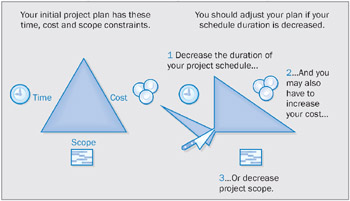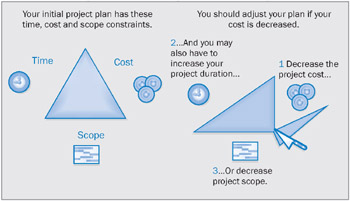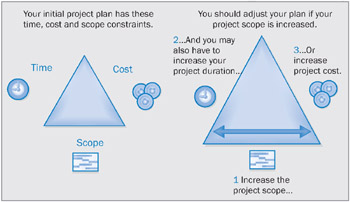Time, Cost, and Scope: Managing Project Constraints
Project management gets most interesting when you must balance the time, cost, and scope constraints of your projects. The project triangle illustrates the process of balancing constraints because the three sides of the triangle are connected, and changing one side of a triangle affects at least one other side.
The following are examples of constraint balance:
-
If the duration (time) of your project schedule decreases, you might need to increase budget (cost) because you must hire more resources to do the same work in less time. If you cannot increase the budget, you might need to reduce the scope because the resources you have cannot complete all of the planned work in less time.

If you must decrease a project’s duration, make sure that overall project quality is not unintentionally lowered. For example, testing and quality control often occur last in a software development project; if project duration is decreased late in the project, those tasks might be the ones to suffer with cutbacks. You must weigh the benefits of decreasing the project duration against the potential downside of a deliverable with poorer quality.
-
If the budget (cost) of your project decreases, you might need more time because you cannot pay for as many resources or for resources of the same efficiency. If you cannot increase the time, you might need to reduce project scope because fewer resources cannot complete all of the planned work in the time remaining.

If you must decrease a project’s budget, you could look at the grades of material resources for which you had budgeted. For example, did you plan to shoot a film in 35 mm when cheaper digital video would do? A lower-grade material is not necessarily a lower-quality material. As long as the grade of material is appropriate for its intended use, it might still be of high quality. As another example, fast food and gourmet are two grades of restaurant food, but you may find high-quality and low-quality examples of each.
You should also look at the costs of the human and equipment resources you have planned to use. Can you hire less experienced people for less money to carry out simpler tasks? Reducing project costs can lead to a poorer-quality deliverable, however. As a project manager, you must consider (or, more likely, communicate to the decision makers) the benefits versus the risks of reducing costs.
-
If your project scope increases, you might need more time or resources (cost) to complete the additional work. When project scope increases after the project has started, it’s called scope creep. Changing project scope midway through a project is not necessarily a bad thing; for example, the environment in which your project deliverable will operate may have changed or become clearer since beginning the project. Changing project scope is a bad thing only if the project manager doesn’t recognize and plan for the new requirements-that is, when other constraints (cost, time) are not correspondingly examined and, if necessary, adjusted.

Time, cost, and scope are the three essential elements of any project. To succeed as a project manager, you should know quite a bit about how all three of these constraints apply to your projects.
Here is our final word about the project triangle model. Like all simple models of complex subjects, this model is a useful learning tool but not always a reflection of the real world. If real projects always performed as the project triangle suggests they should, you might see projects delivered late but at planned cost or with expected scope. Or, projects might be completed on time and with expected scope but at higher cost. In other words, you’d expect to see at least one element of the project triangle come in as planned. But the sad truth is that many projects, even with rigorous project management oversight, are delivered late, over budget, and with far less than expected scope of functionality. You’ve probably participated in a few such projects yourself. As you well know, project management is just plain difficult. Success in project management requires a rare mix of skills and knowledge about schedule practices and tools, as well as skill in the domain or industry in which a project is executed.
EAN: 2147483647
Pages: 247